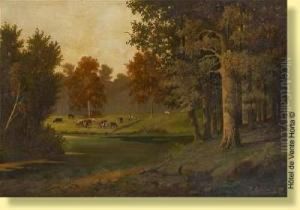Georges Recipon Paintings
Georges Recipon was a French sculptor and painter, born in 1860 and passing away in 1920. He belonged to the era of the Belle Époque, a period characterized by optimism, regional peace, economic prosperity, and technological, scientific, and cultural innovations in France. Recipon is notably remembered for his monumental works that blend the grandeur of the French tradition with the burgeoning styles of the late 19th and early 20th centuries. Recipon's most famous contributions are perhaps the sculptures adorning the Grand Palais in Paris, an iconic symbol of French architectural heritage. He created the quadrigas atop the Grand Palais, which are large sculptural chariots pulled by horses, embodying the spirit of progress and the celebration of art. These works capture the essence of the period's optimism and the glorification of human achievements through the lens of classical mythology. Recipon's ability to infuse classical themes with a modern dynamism reflects the broader artistic movements of his time, such as Art Nouveau, which sought to harmonize traditional forms with the fluidity and organic motifs of the modern age. Beyond his monumental sculptures, Recipon's oeuvre included a variety of works that demonstrated his versatility as an artist. Though less documented, his contributions to painting and smaller-scale sculptures further attest to his skill and creativity. Recipon's legacy is not just in the physical monuments that grace Paris but also in his embodiment of the Belle Époque's artistic spirit. Through his work, he contributed to a cultural heritage that celebrated beauty, innovation, and the human spirit, leaving a lasting impact on the art world and French national identity. Despite his significant contributions, Georges Recipon may not be as widely recognized as some of his contemporaries. However, his work continues to be celebrated for its artistic merit and historical significance, offering insight into the cultural and aesthetic priorities of his time. Recipon's life and career thus remain an important chapter in the history of French art, encapsulating the optimism and creative fervor of the Belle Époque.


